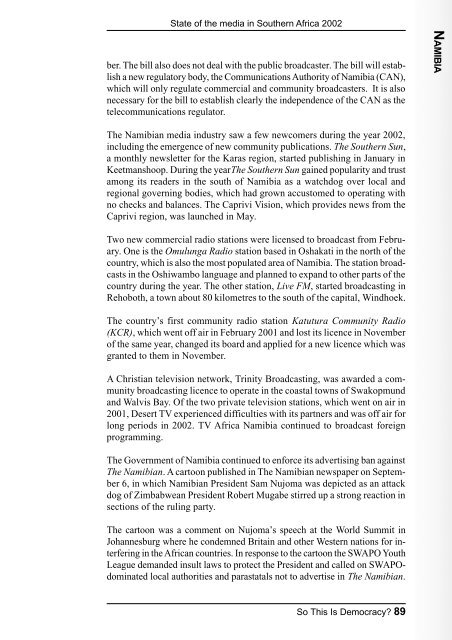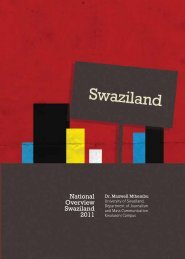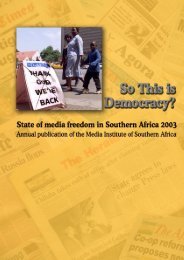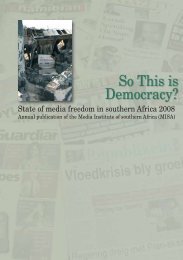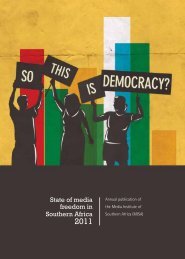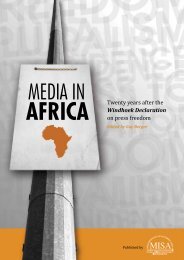Download - Media Institute of Southern Africa
Download - Media Institute of Southern Africa
Download - Media Institute of Southern Africa
You also want an ePaper? Increase the reach of your titles
YUMPU automatically turns print PDFs into web optimized ePapers that Google loves.
NAMIBIA<br />
State <strong>of</strong> the media in <strong>Southern</strong> <strong>Africa</strong> 2002<br />
ber. The bill also does not deal with the public broadcaster. The bill will establish<br />
a new regulatory body, the Communications Authority <strong>of</strong> Namibia (CAN),<br />
which will only regulate commercial and community broadcasters. It is also<br />
necessary for the bill to establish clearly the independence <strong>of</strong> the CAN as the<br />
telecommunications regulator.<br />
The Namibian media industry saw a few newcomers during the year 2002,<br />
including the emergence <strong>of</strong> new community publications. The <strong>Southern</strong> Sun,<br />
a monthly newsletter for the Karas region, started publishing in January in<br />
Keetmanshoop. During the yearThe <strong>Southern</strong> Sun gained popularity and trust<br />
among its readers in the south <strong>of</strong> Namibia as a watchdog over local and<br />
regional governing bodies, which had grown accustomed to operating with<br />
no checks and balances. The Caprivi Vision, which provides news from the<br />
Caprivi region, was launched in May.<br />
Two new commercial radio stations were licensed to broadcast from February.<br />
One is the Omulunga Radio station based in Oshakati in the north <strong>of</strong> the<br />
country, which is also the most populated area <strong>of</strong> Namibia. The station broadcasts<br />
in the Oshiwambo language and planned to expand to other parts <strong>of</strong> the<br />
country during the year. The other station, Live FM, started broadcasting in<br />
Rehoboth, a town about 80 kilometres to the south <strong>of</strong> the capital, Windhoek.<br />
The country’s first community radio station Katutura Community Radio<br />
(KCR), which went <strong>of</strong>f air in February 2001 and lost its licence in November<br />
<strong>of</strong> the same year, changed its board and applied for a new licence which was<br />
granted to them in November.<br />
A Christian television network, Trinity Broadcasting, was awarded a community<br />
broadcasting licence to operate in the coastal towns <strong>of</strong> Swakopmund<br />
and Walvis Bay. Of the two private television stations, which went on air in<br />
2001, Desert TV experienced difficulties with its partners and was <strong>of</strong>f air for<br />
long periods in 2002. TV <strong>Africa</strong> Namibia continued to broadcast foreign<br />
programming.<br />
The Government <strong>of</strong> Namibia continued to enforce its advertising ban against<br />
The Namibian. A cartoon published in The Namibian newspaper on September<br />
6, in which Namibian President Sam Nujoma was depicted as an attack<br />
dog <strong>of</strong> Zimbabwean President Robert Mugabe stirred up a strong reaction in<br />
sections <strong>of</strong> the ruling party.<br />
The cartoon was a comment on Nujoma’s speech at the World Summit in<br />
Johannesburg where he condemned Britain and other Western nations for interfering<br />
in the <strong>Africa</strong>n countries. In response to the cartoon the SWAPO Youth<br />
League demanded insult laws to protect the President and called on SWAPOdominated<br />
local authorities and parastatals not to advertise in The Namibian.<br />
So This Is Democracy? 89


